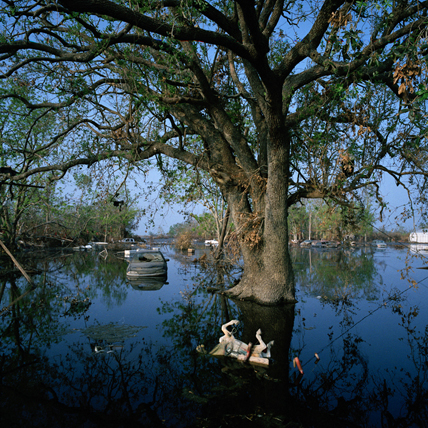
In recognition of the 5th anniversary of Hurricane Katrina’s landfall on the Gulf Coast, Aric Mayer has put together a short film version of his paper “Aesthetics of Catastrophe” (Public Culture 20:2), in which he explores some of the problems and possibilities in covering the immediate aftermath of the storm.
The anniversary will be recognized by a number of other documentaries, but I doubt that serious reflection on Katrina could do better than to start with Aric’s visual essay. And while it is true that substantial investments have been made in respect to civil engineering, I think it is safe to say that much remains to be learned: about what the disaster exposed in American society and government, about that society’s relationship to nature, and, perhaps most important, about the nature of catastrophe itself. Catastrophe involves not only dramatic destruction but also long, slow processes of denial both before and after the event. Hence the double tragedy when the aftermath is defined by the restoration of the same rather than genuine renewal. Aric’s mediation on the first days of the aftermath of Katrina provides a remarkable demonstration of how a natural disaster challenges not only civil engineering but also the civic imagination.
Aric was the principal photographer working for the Wall Street Journal in New Orleans in the weeks after the storm. His solo exhibition of the photographs, titled “Balance + Disorder: Hurricane Katrina and the Photographic Landscape,” was held at Gallery Bienvenu in New Orleans.
You can see the film here, as one of the posts at Aric’s blog.
Photograph by Aric Mayer, Port Sulphur, LA (southern Plaquemines Parish).
So interesting that I read this post today, because I also found this today on the interwebz: http://www.nasa.gov/mission_pages/hurricanes/features/katrina-retrospective.html. It’s a look at the disaster using satellite photos. Unfortunately, the “article” is a video, so you can’t sit and take a good look at the photos, but it made me think about space technology and photo journalism. Here we have essentially a unique work of photo journalism, where the photos are taken from thousands of miles above the subject. Even better, they’re taken by machines (or, at least, that’s how the narration of the video treats them – technically, I assume a human operator would have to build, place, and aim the satellite, but the narrator keeps saying that “the satellite” captured the images, not that “scientists used the satellite to capture the image”, or some such. The satellite becomes a subject).
Talk about a new level of (implied) dispassionate objectivity – images from a God’s-eye-view created by something that’s not human and is so detached from humanity that it doesn’t even exist on the same planet we do.